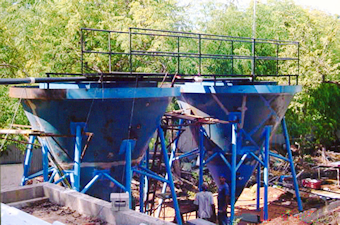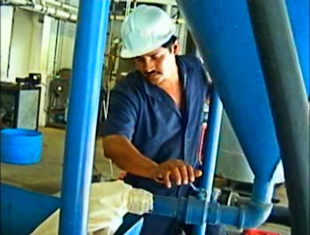

HIDROPUR INDUSTRIAL PHYSICAL-CHEMICAL
 In a large number of occasions the most convenient process to treat industrial wastewater is of the physical-chemical type,
since it is very robust when confronted with various adverse conditions, such as when:
In a large number of occasions the most convenient process to treat industrial wastewater is of the physical-chemical type,
since it is very robust when confronted with various adverse conditions, such as when:
- an influent is contaminated with organic substances that are harmful to or that inhibit biological processes, or when it would be too costly to take said influent to appropriate levels so that it could sustain a bacterial colony.
- the contaminated influent is generated at a discontinuous and/or variable interval, causing prolonged periods of inactivity between batches of water that reach the treatment plant.
- the personnel at a factory is not highly technified (for example in agricultural industries in rural areas).
Furthermore, if the influent contains inorganic contamination, the only viable option is to treat it through a physical-chemical process.
 With these types of process, the level of decontamination obtained hovers around the 70% mark in most cases.
Practically all suspended solids are eliminated and process time is very short. For a physical-chemical plant's functioning
energy is necessary, since we are dealing with a mechanized process, and chemical reagents could be required, depending on the design of each installation.
With these types of process, the level of decontamination obtained hovers around the 70% mark in most cases.
Practically all suspended solids are eliminated and process time is very short. For a physical-chemical plant's functioning
energy is necessary, since we are dealing with a mechanized process, and chemical reagents could be required, depending on the design of each installation.
The following links lead to videos and a photo-gallery of various physical-chemical processes we at Sucrocentro have designed, installed, and started, to treat residual wastewater from the following industries (external links to Youtube):
- Pharmaceutical Laboratories
- Poultry Slaughterhouses (laboratory level techniques)
- Poultry Incubators
- Seafood and maritime products (photo-gallery)
Processes that use chemical reagents consume two types of substances: coagulants y flocculants. The former attacks soluble and insoluble matter, turning the contaminants into insoluble micro-clusters. Through the use of the latter (or air), these clusters clump together, acquiring a greater (or lesser) density than water causing them to precipitate (or float to the top). These precipitates can be separated from process waters through widely known physical procedures.
In all chemical-physical processes we must use (or we can opt to use) various separation and filtration techniques such as decantation, reverse osmosis, evaporation, and ion exchange resins, among many other options.
The following link shows a certificate of satisfaction on behalf of Veralmar S.A. de C.V., a seafood processing factory, regarding
the physical-chemical process we installed in their facilities at La Unión, El Salvador.